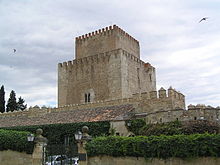| Siege of Ciudad Rodrigo | |||||||
|---|---|---|---|---|---|---|---|
| Part of Peninsular War | |||||||
 Torre del Homenaje del Castillo de Enrique II from the Plaza del Castillo, with a 1507 barrier in the foreground | |||||||
| |||||||
| Belligerents | |||||||
|
|
| ||||||
| Commanders and leaders | |||||||
|
|
| ||||||
| Strength | |||||||
| 28,000 | 5,500 | ||||||
| Casualties and losses | |||||||
| 1,500 | 5,500 | ||||||
| Peninsular War Invasion of Portugal, 1810–1811 | |
|---|---|
125milesVed r asTor r es Fuentes de Oñoro8
In the siege of Ciudad Rodrigo, in Salamanca, Spain, the French Marshal Michel Ney took the fortified city from Field Marshal Andrés Pérez de Herrasti on 10 July 1810 after a siege that began on 26 April. Ney's VI Corps made up part of a 65,000-strong army commanded by André Masséna, who was bent on a third French invasion of Portugal.
Background
The Third Portuguese campaign started with the construction of the Lines of Torres Vedras and the Siege of Ciudad Rodrigo.
Forces
Ney's VI Corps included Jean Marchand's 1st Division (6,500), Julien Mermet's 2nd Division (7,400), Louis Loison's 3rd Division (6,600), Auguste Lamotte's corps light cavalry brigade (900), Charles Gardanne's mounted dragoon brigade (1,300) and 60 cannon.
Herrasti commanded three regular battalions from the Avila, Segovia and 1st Majorca Infantry Regiments, 375 artillerymen and 60 sappers. These troops were supplemented by three battalions of the Volunteers of Ciudad Rodrigo and one battalion of the Urban Guard.
Siege
Initially hoping to be relieved by the British Light under Brigadier General Robert Craufurd, which was nearby, in accordance with the aid that had been promised, Herrasti refused the initial offer to surrender. Viscount Wellington was not however prepared to meet the French in open battle, as he was greatly outnumbered, resting on the Portuguese frontier to await the outcome of the siege.
Herrasti's 5,500-man Spanish garrison put up a gallant and sustained defence, for over ten weeks, surrendering only after the counterscarp had been blown in, Ney's artillery opened practical breaches in the walls and the French infantry were poised for an assault. Herrasti met Ney at the foot of the breach and having been offered the chance of an honourable capitulation, accepted. "Ney promised that the people and property of the inhabitants of the city would be respected. However, all the men who had participated in the defence, and the members of the Central Junta who had encouraged it, would be taken as prisoners to France."
The Spanish suffered 461 killed and 994 wounded, while 4,000 men and 118 cannon were captured. Ney's VI Corps lost 180 killed and over 1,000 wounded during the siege. The French troops then pillaged the city, breaking Ney's promise. The siege delayed Masséna's invasion of Portugal by over a month.
Aftermath
The Third Portuguese campaign proceeded with the advance of the French troops, following up the retreating British resulting in the Battle of the Côa. The siege of Almeida was started and ended suddenly with a massive explosion of the fortress magazine on 26 August. With all obstacles cleared from their path, the French could march on Lisbon in strength.
A defensive battle, the Battle of Bussaco, was fought, which gave the French a bloody nose, before the British and Portuguese fell back on the Lines of Torres Vedras which were completed as the troops arrived. The lines were designed to enable a successful defence of Lisbon and avoid a British evacuation of the peninsular, as had happened after the Battle of Corunna in January 1809.
The delay in capturing Ciudad Rodrigo gave many precious weeks of time to enable the Lines of Torres Vedras to be completed and therefore contributed greatly to the Allied victory of the Peninsular War.
A second siege of Ciudad Rodrigo occurred in January 1812, with the French being besieged this time, losing the town after a short two-week siege.
Notes
- ^ Bodart 1908, p. 418.
- ^ Mas 2021.
- Porter 1889, p. 277.
References
- Bodart, Gaston (1908). Militär-historisches Kriegs-Lexikon (1618-1905). Retrieved 25 May 2021.
- Porter, Maj Gen Whitworth (1889). History of the Corps of Royal Engineers Vol I. Chatham: The Institution of Royal Engineers.
- Mas, Miguel Martín Angel (2021). "Perez de Herrasti, Governor of Ciudad Rodrigo: "the thumb breaks but does not bend"". Archived from the original on 3 March 2021. Retrieved 25 May 2021.
Further reading
- Chandler, David (1979). Dictionary of the Napoleonic Wars. Macmillan.
- Glover, Michael (1974). The Peninsular War 1807–1814. Penguin.
- Horward, Donald (1973). The French Campaign in Portugal 1810–1811: An Account by Jean Jacques Pelet. University of Minnesota.
- Smith, Digby (1998). The Napoleonic Wars Data Book. Greenhill.
- Herrasti, Andrés Perez de (2021). Relacion historica y circunstanciada de los sucesos del sitio de la plaza de Ciudad-Rodrigo en el año de 1810 [Historical and Detailed Account of the Events of the Siege of Ciudad Rodrigo in 1810]. MDZ.
External links
 Media related to Siege of Ciudad Rodrigo (1810) at Wikimedia Commons
Media related to Siege of Ciudad Rodrigo (1810) at Wikimedia Commons
| Preceded by Siege of Astorga |
Napoleonic Wars Siege of Ciudad Rodrigo (1810) |
Succeeded by Combat of Barquilla (1810) |